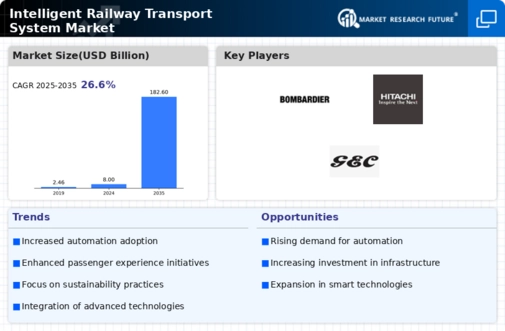Market Trends
Key Emerging Trends in the Intelligent Railway Transport System Market
The Intelligent Railway Transport System (IRTS) market is witnessing dynamic trends that are reshaping the future of rail transportation. One prominent trend is the rapid integration of digital technologies, such as Internet of Things (IoT) sensors and data analytics, to enhance operational efficiency. Railways around the world are increasingly adopting smart systems that enable real-time monitoring of train performance, track conditions, and passenger flow. This data-driven approach allows for predictive maintenance, minimizing downtime, and optimizing overall system reliability. A key point in the IRTS market is putting more focus on being environmentally friendly. With attention around the world on cutting down carbon emissions and supporting green ways, railway companies are adding in energy-saving tools to their systems. For example, trains can use a system called regenerative braking to get back and reuse energy when slowing down. This helps make train travel better for the environment. This change goes along with the bigger plans to make cities' transportation better for nature and more eco-friendly.
Automation and smart technology are important changes that make the IRTS market better. Automation makes train stuff like buying tickets and planning trips easier. It also helps with taking care of trains and keeping them safe to use. AI-made rules help guess what might happen in the future. This lets train workers see upcoming problems and solve them before they become a concern, making trains more trustworthy and safe overall. As these technologies keep getting better, more automated train operations will happen. This way we can have smart and automatic railway systems in the future.
The IRTS world is being changed by a major trend called interconnectivity. The connection of talk tools and the Internet things (IoT) is helping easy links between parts of train systems. This connected system makes it easy for trains, stations and control centers to talk. It helps them make better choices quickly which improves how everything works together in the overall plan. The change to a more linked train system is important for making an easy-to-use and adjustable travel network.
In answer to the growing need for services that focus on customers, the IRTS market is seeing a shift towards improving how passengers feel all together. Train companies are adding things like Wi-Fi, entertainment systems and smart passenger info to make travel more fun and easier. Also, using mobile apps for buying tickets and planning trips makes it easy and user-friendly for passengers. This thing shows that people are starting to understand how important it is for customers to be happy with smart train systems. However, challenges persist within the market, including the high initial costs of implementing intelligent railway solutions, interoperability issues, and the need for skilled personnel to operate and maintain advanced systems. Overcoming these challenges will be crucial for the widespread adoption of intelligent technologies within the railway sector.





Leave a Comment